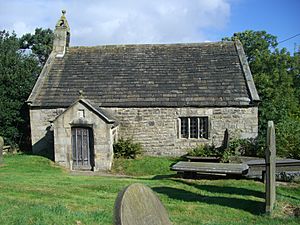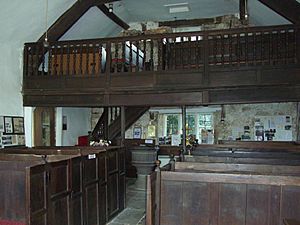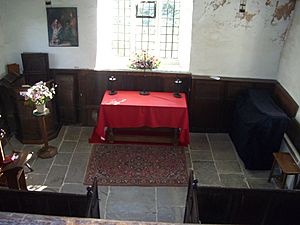St James' Church, Midhopestones facts for kids
St James’ Church, Midhopestones is a small, old church located in a quiet village called Midhopestones. This village is just inside the northern part of Sheffield in South Yorkshire, England. Since April 1969, it has been a special "Grade II* listed building". This means it's a very important historical building that needs to be protected. People often call St James' a chapel because it's quite small, and it's even found on a street called Chapel Lane! The church is officially named after James the Less. However, some people think it should be named after James the Greater. This is because there are scallop shells carved above the church door, which are a symbol for James the Greater. It's thought that the church might have been renamed to James the Less during the Victorian era because of its small size. Today, the church is part of the Parish of Penistone in the Diocese of Wakefield.
Contents
History of St James’ Church
How the Church Began
St James’ Church was started by the Barnby family, who lived at Barnby Hall in Cawthorne. Thomas de Barnby, who was a vicar (a type of priest) in Kirkheaton, became the main owner of the land in Midhope in 1337. His nephew, Robert, took over in 1354. Robert de Barnby probably founded the church around the year 1360. Some experts think Thomas de Barnby might have started it a little earlier.
The church was built as a Chapel of ease. This meant it was a smaller church built for people who lived far from the main parish church, St. Marys’ in Ecclesfield. St. Marys’ was about 14 kilometers (about 9 miles) away to the east. The Barnby family used St James’ as their own private chapel. But in 1622, they had to sell all their land. This was because they faced money problems from fines. These fines were given after the English Reformation for attending Mass (a Catholic church service) instead of going to the official state church.
Between 1622 and 1690, the church was owned by Puritans. They put in a tall Jacobean pulpit. This pulpit was so high that the preacher could see out of the window! This pulpit is still the most valuable old item in the church today. In the late 1600s, the chapel started to fall apart.
The 1705 Church Restoration
In 1705, Godfrey Bosville restored the church. He became the owner of the land in 1690. Bosville rebuilt parts of the east and west ends of the church. He also added the porch, a Minstrels' gallery (a balcony for musicians), box pews (enclosed seating areas), and a bell cupola (a small dome-like structure for the bell).
Godfrey Bosville had his family's coat of arms carved above the porch door. He also had his and his wife Bridget's initials carved there. This showed that he thought of the church as his own family chapel. This made many local people unhappy.
Until 1847, priests from the nearby St Mary's Church, Bolsterstone held services at St James’. All records of births, marriages, and deaths were kept at St Mary's. After 1847, priests from Penistone started to hold the services. The bell in the cupola was replaced in 1858 and again in 1929. The church's graveyard was first created in the 1700s and was made bigger in 1915.
Recent Changes to the Church
In 1967, a joiner (a woodworker) doing repairs found a secret trap door between the pulpit and the altar. This made people wonder if there was an old tunnel connecting the church to the old manor house. However, no tunnel was ever found. People now believe it was a hidden spot where the church's valuable silver items were kept safe long ago.
In 1978, more renovations took place. During these changes, the pulpit was made shorter to its current height. The old brass candlesticks and cross were replaced with new ones made of wrought iron. Some of the front box pews were removed. The oak wood from these pews was then used to make new inner doors and a desk and chair for the priest. Also during the 1978 renovations, a large, very old stone altar was discovered in the south wall. This ancient altar is now used in Saint John the Baptist Church, Penistone.




